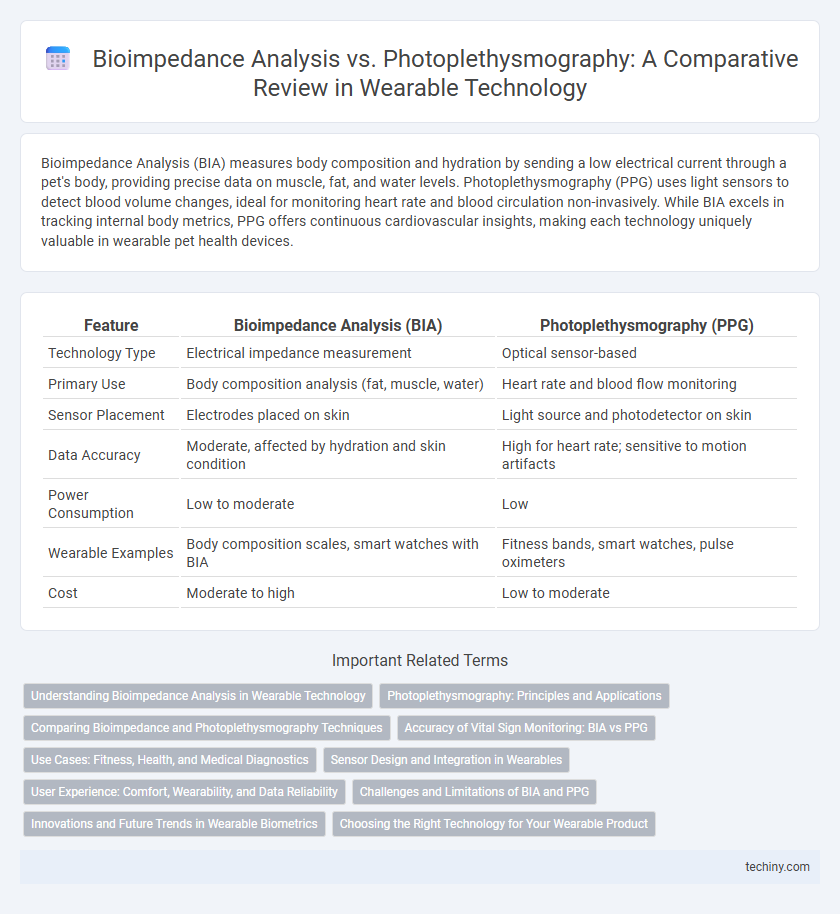Bioimpedance Analysis (BIA) measures body composition and hydration by sending a low electrical current through a pet's body, providing precise data on muscle, fat, and water levels. Photoplethysmography (PPG) uses light sensors to detect blood volume changes, ideal for monitoring heart rate and blood circulation non-invasively. While BIA excels in tracking internal body metrics, PPG offers continuous cardiovascular insights, making each technology uniquely valuable in wearable pet health devices.
Table of Comparison
| Feature | Bioimpedance Analysis (BIA) | Photoplethysmography (PPG) |
|---|---|---|
| Technology Type | Electrical impedance measurement | Optical sensor-based |
| Primary Use | Body composition analysis (fat, muscle, water) | Heart rate and blood flow monitoring |
| Sensor Placement | Electrodes placed on skin | Light source and photodetector on skin |
| Data Accuracy | Moderate, affected by hydration and skin condition | High for heart rate; sensitive to motion artifacts |
| Power Consumption | Low to moderate | Low |
| Wearable Examples | Body composition scales, smart watches with BIA | Fitness bands, smart watches, pulse oximeters |
| Cost | Moderate to high | Low to moderate |
Understanding Bioimpedance Analysis in Wearable Technology
Bioimpedance analysis (BIA) in wearable technology measures the body's resistance to a low electrical current to estimate body composition, including fat mass, muscle mass, and hydration levels. This technique provides continuous, non-invasive monitoring that helps track fitness progress, hydration status, and overall health in real time. BIA's accuracy depends on electrode placement and device calibration, making it a preferred method for detailed biometric data compared to photoplethysmography, which primarily monitors blood flow and heart rate.
Photoplethysmography: Principles and Applications
Photoplethysmography (PPG) utilizes light-based technology to measure blood volume changes in microvascular tissue, enabling non-invasive monitoring of heart rate, blood oxygen saturation, and vascular health. Employed extensively in wearable devices like smartwatches and fitness trackers, PPG sensors capture photodetector signals reflecting pulsatile blood flow, providing real-time cardiovascular metrics. Its applications extend to remote health monitoring, sleep analysis, and exercise physiology, making it a cornerstone in personalized health and fitness technology.
Comparing Bioimpedance and Photoplethysmography Techniques
Bioimpedance analysis measures body composition and fluid levels by detecting electrical impedance variations in tissues, providing accurate assessments of hydration and fat mass. Photoplethysmography employs light absorption changes to monitor blood volume and heart rate, enabling real-time cardiovascular tracking with minimal hardware. Comparing these techniques reveals bioimpedance excels in body composition analysis, while photoplethysmography is superior for continuous cardiovascular monitoring in wearable devices.
Accuracy of Vital Sign Monitoring: BIA vs PPG
Bioimpedance Analysis (BIA) offers higher accuracy in measuring body composition and hydration levels by detecting electrical impedance through tissues, providing reliable insights into bio-signals. Photoplethysmography (PPG) excels in real-time heart rate and oxygen saturation monitoring by measuring blood volume changes with light absorption but can be affected by motion artifacts and ambient light interference. BIA's precision in vital sign monitoring is generally superior for comprehensive metabolic analysis, while PPG is preferred for continuous cardiovascular monitoring in wearable devices.
Use Cases: Fitness, Health, and Medical Diagnostics
Bioimpedance Analysis (BIA) excels in assessing body composition metrics such as fat percentage, muscle mass, and hydration levels, making it ideal for fitness tracking and nutritional planning. Photoplethysmography (PPG) measures blood volume changes non-invasively, providing real-time heart rate, oxygen saturation, and vascular health monitoring crucial for both health maintenance and medical diagnostics. Fitness devices often integrate BIA for body metrics while leveraging PPG for cardiovascular monitoring, whereas medical diagnostics rely heavily on PPG for detecting arrhythmias and vascular conditions.
Sensor Design and Integration in Wearables
Bioimpedance Analysis (BIA) sensors in wearables utilize low-level electrical currents to measure body composition by detecting impedance changes, requiring electrodes designed for stable skin contact and minimal motion artifacts. Photoplethysmography (PPG) sensors rely on optical components, including LEDs and photodetectors, integrated into flexible substrates to capture blood volume changes through light absorption, emphasizing miniaturization and skin conformity. Sensor design for wearables prioritizes seamless integration, power efficiency, and reliable data acquisition despite user movements and environmental variations.
User Experience: Comfort, Wearability, and Data Reliability
Bioimpedance Analysis offers high data reliability for body composition metrics but often requires firm skin contact, which can impact comfort and long-term wearability. Photoplethysmography, commonly used in smartwatches and fitness bands, provides a more comfortable and lightweight experience with non-invasive optical sensors, enhancing user compliance during extended wear. Both technologies balance accuracy and comfort differently, with PPG excelling in daily usability and BIA delivering precise measurements in controlled conditions.
Challenges and Limitations of BIA and PPG
Bioimpedance Analysis (BIA) in wearable technology faces challenges such as signal interference from varying hydration levels and body composition, which can lead to inaccurate measurements. Photoplethysmography (PPG) struggles with motion artifacts and variations in skin tone that affect light absorption, compromising heart rate and blood oxygen monitoring accuracy. Both methods require advanced algorithms and calibration to mitigate these limitations and improve reliability in real-world conditions.
Innovations and Future Trends in Wearable Biometrics
Bioimpedance Analysis (BIA) and Photoplethysmography (PPG) represent cutting-edge advancements in wearable biometric technology, with BIA excelling in body composition and hydration assessment through electrical impedance, while PPG offers continuous cardiovascular monitoring by measuring blood volume changes using optical sensors. Emerging trends emphasize integrating AI-driven analytics and multi-modal sensor fusion to enhance accuracy and provide real-time health insights. Future innovations anticipate miniaturized, energy-efficient wearables capable of seamless biomarker detection for personalized preventive healthcare and chronic disease management.
Choosing the Right Technology for Your Wearable Product
Bioimpedance Analysis (BIA) offers precise body composition metrics by measuring electrical resistance through tissues, making it ideal for fitness and health monitoring wearables focused on fat, muscle, and hydration levels. Photoplethysmography (PPG) excels in tracking cardiovascular health by detecting blood volume changes via optical sensors, providing accurate heart rate and oxygen saturation data. Selecting the right technology depends on the wearable's primary function: BIA suits users prioritizing body composition insights, while PPG is preferable for continuous cardiovascular monitoring.
Bioimpedance Analysis vs Photoplethysmography Infographic

 techiny.com
techiny.com